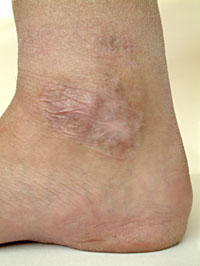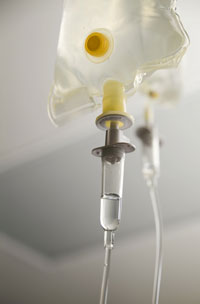
What is a burn?
A burn is tissue damage caused by heat, chemicals, electricity, sunlight, or nuclear radiation. The most common burns are those caused by scalds, building fires, and flammable liquids and gases.
- First-degree burns affect only the outer layer (the epidermis) of the skin.
- Second-degree burns damage the epidermis and the layer beneath it (the dermis).
- Third-degree burns involve damage or complete destruction of the skin to its full depth and damage to underlying tissues. People with third-degree burns often need skin grafts.

How does the body react to a severe burn?
The swelling and blistering characteristic of burns is caused by the loss of fluid from damaged blood vessels. In severe cases, such fluid loss can cause shock. Immediate blood transfusion and/or extra fluids are needed to maintain blood pressure. Grafting with natural or artificial materials speeds the post-burn healing process.
What are the other effects of burns?
Burns often lead to infection, due to damage to the skin's protective barrier. In many cases, topical antibiotics (skin creams or ointments) are used to prevent infection.
What is the prognosis for severe burn victims?
Twenty-five years ago, burns covering half the body were often fatal. Now, thanks to research, people with burns covering 90 percent of their bodies survive, although they often have permanent impairments and scars.

Where are people treated for burns?
Over half of burn patients in the United States are treated in specialized burn centers, and most hospitals have trauma teams that care exclusively for patients with traumatic injuries that may accompany burns.
How has basic research improved burn care?
Remarkable improvements in burn care have resulted from basic research funded by the National Institutes of Health. The results have led to the best approaches for fluid resuscitation, wound cleaning, skin replacement, infection control, and nutritional support.
What is on the horizon for burn research?
Improving methods for wound healing and tissue repair offer tremendous opportunities to enhance the quality of life for trauma and burn patients and may also help to reduce health care costs.
Where can I find more information about burns?
- The Alisa Ann Ruch Burn Foundation is a nonprofit health organization dedicated to burn prevention and survivor assistance.
- The American Burn Association is a nonprofit health association dedicated to addressing the problems of burn injuries and burn survivors throughout the United States, Canada, and other countries.
- Burn Survivor.org is a nonprofit organization focused on education, prevention, and the non-medical and emotional issues related to burn care.
- MEDLINEplus Health Topics: Burns is an NIH National Library of Medicine Web site containing information and links about burns and burn research.
- The Phoenix Society for Burn Survivors is an international, nonprofit organization helping burn survivors and their families.
- Shriners Hospitals for Children is a nationwide network of hospitals that provide no-cost orthopedic and burn care to children under 18 years of age, regardless of financial need.
Content created July 2008
